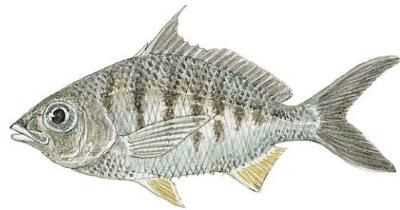Striped Mojarra

Species Details
Eugerres Plumieri
Gerreidae
Perciformes
Inlets, Tidal Pools
1 - 2 lbs.
6" - 16"
Striped Mojarra (Eugerres plumieri) Fish Description
The Striped Mojarra is easily confused with the Maracaibo Mojarra and the Black Axillary Mojarra. Compared to the Striped Mojarra, the Maracaibo Mojarra’s second anal spine goes beyond the tail base. On the other hand, the Black Axillary Mojarra is found in the Pacific Ocean only. The Striped Mojarra is also known as Silverbelly, Sand Perch, Silverbiddy, Sand Brim, Goat, and Goatfish.
The body of the Striped Mojarra is shaped like a rhombus; it is compressed and looks silvery. Its back part is greenish in color. The Striped Mojarras’ dorsal fins have thin lines and are dark; the other fins are dusky. They have an anal fin with 3 spines and 8 or 9 rays. Their caudal fin is forked, whereas their dorsal fin is elevated and contains 10 rays and 9 spines. The Striped Mojarras’ long pectoral fins have 16 to 17 rays. Their pelvic fins have one strong, thick spine.
Striped Mojarras have serrated gill covers.
Diet and Size
Striped Mojarras generally feast on detritus, micro-bivalves, crustaceans, and aquatic insects. They particularly love to feed on shrimps.
On average, the Striped Mojarra grows from 6 inches up to 16 inches in length. It weighs 0.2 up to 2.45 pounds.
Interesting Facts About the Striped Mojarra
- The Striped Mojarra is known as mojarra rayada in Mexico.
- This species is considered one of the most important fishes in the Colombian Caribbean.
- It appears like the Striped Mojarra has a mouth within a mouth. It looks like its mouth pulls away from its head/face.
- Female Striped Mojarras are generally fertile, and can lay around 90, 000 to 1,00,000 eggs every year.
- Striped Mojarras are curious and tend to nibble at anything to know how it tastes.
Fishing Techniques
The IUCN labeled Striped Mojarras as species of Least Concern. Their population is stable and widely distributed, fortunately for anglers. In addition, Striped Mojarras swim in large schools, making it easy for anglers to catch them using a seine net or a cast net.
Anglers can use squid, scud, and grasshopper as effective baits to capture Striped Mojarras. It would be best if the bait is shrimp without the shell; worms and small minnows can also be used. In return, this fish, along with Sand Perch and Sand Brim, are excellent baits for other types of fishes.
To fish for Striped Mojarras, anglers can use a rod and reel with a size-6 hook and bobber. The best season for capturing this species is between the months of April and June, then September to December.
When low on baits, anglers may also use lures like floating rapala.
Habitat and Distribution
This species of fish thrives in shallow waters, lagoons, and mangrove-rich creeks, with low salinity. Striped Mojarras like fresh, salt, and brackish waters alike up to 100 feet deep. They live and feed near or on the bottom of the oceans.
Striped Mojarras are generally found in the Caribbean, Central and South American Coast, and the Western Atlantic, specifically South Carolina to western Florida. They also thrive in the Gulf of Mexico and swim up to the waters of Brazil.







